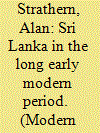|
|
|
Sort Order |
|
|
|
Items / Page
|
|
|
|
|
|
|
| Srl | Item |
| 1 |
ID:
089879


|
|
|
|
|
| Publication |
2009.
|
| Summary/Abstract |
This paper explores how Sri Lanka might fit into Victor Lieberman's theory of Eurasian history. Lieberman's work to date has focused on the 'protected rimlands' which he sees as sharing the same historical path from a milieu of warring little kingdoms to increasingly large, solid states. But what happens in a land, such as Sri Lanka, which can be considered 'protected' before 1500, and 'unprotected' thereafter? Political integration and boundaries are first discussed, followed by ethnic and historical awareness before 1500. The third section sketches the chronological development of Buddhism before 1500, while the fourth considers the impact of the European interruption, and the fifth briefly looks at the results for 1600-1800. Along the way, some problems with applying the notion of 'early modernity' to Sri Lanka are disclosed.
|
|
|
|
|
|
|
|
|
|
|
|
|
|
|
|
| 2 |
ID:
090302


|
|
|
|
|
| Publication |
2009.
|
| Summary/Abstract |
This paper explores how Sri Lanka might fit into Victor Lieberman's theory of Eurasian history. Lieberman's work to date has focused on the 'protected rimlands' which he sees as sharing the same historical path from a milieu of warring little kingdoms to increasingly large, solid states. But what happens in a land, such as Sri Lanka, which can be considered 'protected' before 1500, and 'unprotected' thereafter? Political integration and boundaries are first discussed, followed by ethnic and historical awareness before 1500. The third section sketches the chronological development of Buddhism before 1500, while the fourth considers the impact of the European interruption, and the fifth briefly looks at the results for 1600-1800. Along the way, some problems with applying the notion of 'early modernity' to Sri Lanka are disclosed.
|
|
|
|
|
|
|
|
|
|
|
|
|
|
|
|
| 3 |
ID:
185807


|
|
|
|
|
| Summary/Abstract |
In the 1680s, King Narai, ruler of the cosmopolitan kingdom of Ayutthaya, was the subject of competing French and Persian attempts to convert him to monotheism. These attempts were not only embarrassing failures; they also helped to precipitate a coup in 1688, in which Phetracha forcefully intervened to place himself on the throne and eject French influence from the realm. But to what extent did the execution of the coup depend on popular involvement? And what ideals and emotions seem to have animated this participation? After pondering the role of ethnicity and xenophobic sentiment, this article considers the construction of powerful discourses of Buddhist intellectual opposition to Christianity, the role of the sangha in the orchestration of the coup itself, and then considers in more detail the extent to which ‘the people’ demonstrated some kind of autonomous political agency. Lastly, it considers whether the events of the coup and its immediate aftermath were shaped by anti-Christian emotion. As a movement with conservative and restorative aims, 1688 was not a ‘revolution’ in the modern sense, but it may have ushered in an enlarged sense of popular investment in the legitimation of royal contenders associated with the defence of Buddhism.
|
|
|
|
|
|
|
|
|
|
|
|
|
|
|
|
|
|
|
|
|